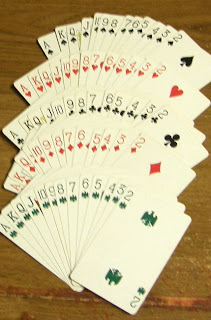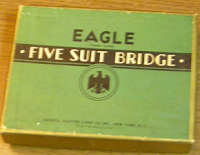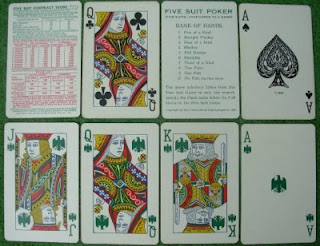Five-Suited Poker
 The history of playing cards dates way, way back, well before anything resembling poker.
The history of playing cards dates way, way back, well before anything resembling poker.Most historians point to east Asia to the Korean peninsula and China for early references to cards, going all of the way back to the seventh and eighth centuries to find cards made from strips of silk. By the year 1000 and after come more frequent references to cards and card games, particularly in China (where paper was invented). It would take another few hundred years -- until the late 14th century or so -- before cards began turning up in Europe.
By the time cards came to Europe there were already examples of 52-card decks, although there were also some decks of 36 cards, 40 cards, and other amounts. One 52-card deck that turned up in Italy by way of Persia featured four suits -- coins, cups, scimitars, and polo sticks. As cards spread across Europe came the introduction of court figures (kings, queens, knaves) as well as the four suits (spades, hearts, diamonds, and clubs) printed in red and black.
All of that happened by the late 15th century or so, meaning when it comes to playing cards, games with 52 cards and the four suits with which we are familiar has pretty much been the norm for the entire modern era.
Thus a lot of precursors to poker like mus (Spain), poch (Germany), primiera (Italy), brag (England), and poque (France) were usually played with similar decks, as was poker when it first came about in the early 19th century. Some of those games featured smaller decks (several with just 40 cards), but all were played with four suits. (One other game considered an ancestor of poker, the Persian game As nas, was actually played with a 25-card deck with five suits.)
Subsequently, just about all variants of poker have been played with four suits during the two centuries the game has been around, but attempts have been made now and then to introduce a fifth suit. Probably the most notable of these attempts occurred in the late 1930s when a five-suited, 65-card deck was briefly introduced.
 In the United States, the fifth suit -- “eagles” -- was printed in green. Around the same time in England there were five-suited decks produced with the fifth suit printed in blue and called “royals.”
In the United States, the fifth suit -- “eagles” -- was printed in green. Around the same time in England there were five-suited decks produced with the fifth suit printed in blue and called “royals.”In truth, the five-suited decks were not really made for poker but rather for bridge, which by the late 1930s was enjoying a major boom in popularity in the U.S. According to “As They Saw It” (a neat website that compiles information from news articles about various 20th-century topics), there were something between 12 and 15 million bridge players in America at this time. Worldwide the game had taken off in a big way, too, with the World Bridge Olympic in 1938 attracting nearly 200,000 players from 57 different countries.
Much as we’ve seen happen in poker over the last decade with the introduction of new games coming in the wake of the explosion in popularity that has occurred, the bridge boom also inspired some attempts at innovation, including the idea of five-suited bridge. Apparently the idea originated in Austria, moved over to England, then made it to the U.S.
It sounds like the introduction of five-suited bridge got a lot of publicity in the U.S. with many wanting to get the new decks and give it a shot. The game only remained in the spotlight for a short while, however, as the five-suited game proved too cumbersome. The contract bridge master Ely Culbertson pronounced at the time that “the average player has not yet thoroughly learned how to play with four suits, let alone five,” correctly signaling that five-suited bridge would likely be just a fad.
 Card manufacturers quickly stopped producing the five-suited decks, but a few found their way into poker games here and there, which I imagine led to some interesting variations. Indeed, you can see in this picture there was included in the five-suited decks a card indicating hand rankings for “five suit poker,” with a five-of-a-kind beating a straight flush.
Card manufacturers quickly stopped producing the five-suited decks, but a few found their way into poker games here and there, which I imagine led to some interesting variations. Indeed, you can see in this picture there was included in the five-suited decks a card indicating hand rankings for “five suit poker,” with a five-of-a-kind beating a straight flush.Today there is a company called Stardeck that continues to produce five-suited decks (their fifth suit is “stars”). Their website has some interesting discussion of how the fifth suit comes into play in traditional poker games as well as some other historical anecdotes about five-suited card games, if you are curious to read more.
In his 1945 Pocketbook of Games, Albert Morehead made mention of the already scarce five-suited decks, noting how “a five-suit bridge game was widely played for some months, but was soon forgotten.” Morehead also opines that “five-suit poker made a better game, but can seldom be played today because the cards are no longer generally on sale.”
Morehead doesn’t back up that claim with any evidence to support why five-suited poker was better, although if you hunt around the Stardeck site you’ll see “testimonials” regarding five-suited card games, one of which mentions how the larger deck makes it possible to accommodate more players.
Fun to think about the existence of a fifth suit, even in theory. In fact it’s probably more fun in theory than in practice, although never having played with such a deck I can’t say for certain what it feels like to draw an eagle flush.
Labels: *the rumble, five-suited poker, history














0 Comments:
Post a Comment
<< Home